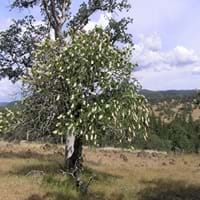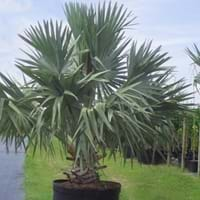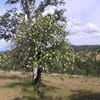Life Span
Perennial
Perennial
Origin
California
Madagascar
Types
Not Available
Not Available
Habitat
Hillside
Subtropical climates, tropical environments
USDA Hardiness Zone
7-9
10-15
Sunset Zone
3a, 3b, 4, 5, 6, 7, 8, 9, 10, 14, 15, 16, 17, 18, 19, 20, 21, 22, 23, 24
H1, H2, 22, 23, 24
Habit
Oval or Rounded
Oval or Rounded
Flower Color
White, Pink
Light Yellow
Flower Color Modifier
Bicolor
Bicolor
Fruit Color
Yellow Brown
Brown, Chocolate
Leaf Color in Spring
Light Green
Blue Green, Silver, Gray
Leaf Color in Summer
Green
Silver, Gray
Leaf Color in Fall
Not Available
Silver, Gray
Leaf Color in Winter
Not Available
Silver, Gray
Leaf Shape
Oval
Costapalmate
Plant Season
Spring, Summer, Fall, Winter
Spring, Summer, Fall, Winter
Sunlight
Full Sun, Partial Sun
Full Sun, Partial Sun
Growth Rate
Medium
Medium
Type of Soil
Clay, Loam, Sand
Loam, Sand
The pH of Soil
Acidic, Neutral
Acidic, Neutral, Alkaline
Soil Drainage
Well drained
Well drained
Bloom Time
Late Spring, Early Summer
Indeterminate
Tolerances
Drought, Salt
Drought, Salt
Where to Plant?
Ground
Container, Ground, Pot
How to Plant?
Seedlings
Seedlings
Plant Maintenance
Medium
Medium
Watering Requirements
Keep the ground moist but not water-logged, Requires regular watering, Requires watering in the growing season
Average Water Needs
In Summer
Lots of watering
Lots of watering
In Spring
Moderate
Moderate
In Winter
Average Water
Average Water
Soil pH
Acidic, Neutral
Acidic, Neutral, Alkaline
Soil Type
Clay, Loam, Sand
Loam, Sand
Soil Drainage Capacity
Well drained
Well drained
Sun Exposure
Full Sun, Partial Sun
Full Sun, Partial Sun
Pruning
Remove damaged leaves, Remove dead leaves, Remove dead or diseased plant parts
Remove damaged leaves, Remove dead branches, Remove dead leaves
Fertilizers
All-Purpose Liquid Fertilizer
All-Purpose Liquid Fertilizer
Pests and Diseases
Red blotch
Larva, Palmetto weevil
Plant Tolerance
Drought
Drought
Flower Petal Number
Not Available
Single
Foliage Texture
Medium
Bold
Foliage Sheen
Glossy
Matte
Attracts
Birds, Butterflies
Hummingbirds
Allergy
Not Available
Oral Cancers
Aesthetic Uses
Beautification, Landscape Designing, Showy Purposes
Showy Purposes
Beauty Benefits
Not Available
Not Available
Environmental Uses
Air purification
Air purification
Medicinal Uses
Not Available
Antidepressant
Part of Plant Used
Fruits
Nut
Other Uses
Decoration Purposes, Showy Purposes, Used as Ornamental plant
Chewing
Used As Indoor Plant
No
Sometimes
Used As Outdoor Plant
Yes
Yes
Garden Design
Dried Flower, Everlasting, Feature Plant, Hedges, Mixed Border, Screening, Wind Break
Feature Plant, Foundation, Tropical
Botanical Name
AESCULUS californica
BISMARCKIA nobilis
Common Name
California Buckeye
Bismarck Palm
In Hindi
कैलिफोर्निया Buckeye
Bismarck Palm
In German
California Buckeye
Bismarck Palm
In French
California Buckeye
Bismarck Palm
In Spanish
California Buckeye
Bismarck Palm
In Greek
Καλιφόρνια Buckeye
Bismarck Palm
In Portuguese
California Buckeye
Bismarck Palm
In Polish
Kalifornia Buckeye
Bismarck Palm
In Latin
California Buckeye
Bismarck Palm
Phylum
Magnoliophyta
Magnoliophyta
Class
Magnoliopsida
Monocotyledonae
Order
Sapindales
Arecales
Family
Sapindaceae
Arecaceae
Genus
Aesculus
Bismarckia
Clade
Angiosperms, Eudicots, Rosids
Angiosperms, Commelinids, Monocots
Tribe
Not Available
Borasseae
Subfamily
Hippocastanoideae
Coryphoideae
Number of Species
Not Available
Properties of California Buckeye and Bismarck Palm
Wondering what are the properties of California Buckeye and Bismarck Palm? We provide you with everything About California Buckeye and Bismarck Palm. California Buckeye doesn't have thorns and Bismarck Palm doesn't have thorns. Also California Buckeye does not have fragrant flowers. California Buckeye has allergic reactions like Not Available and Bismarck Palm has allergic reactions like Not Available. Compare all the properties and characteristics of these two plants. Find out which of these plant can be used as indoor plant. If you are interested to decorate your house and garden, find out aesthetic uses, compare them and select the plant which will beautify your surrounding. Along with beautification, try comparing medicinal and edible uses of California Buckeye and Bismarck Palm and you can choose the plant having best and most benefits.
Season and Care of California Buckeye and Bismarck Palm
Season and care of California Buckeye and Bismarck Palm is important to know. While considering everything about California Buckeye and Bismarck Palm Care, growing season is an essential factor. California Buckeye season is Spring, Summer, Fall and Winter and Bismarck Palm season is Spring, Summer, Fall and Winter. The type of soil for California Buckeye is Clay, Loam, Sand and for Bismarck Palm is Loam, Sand while the PH of soil for California Buckeye is Acidic, Neutral and for Bismarck Palm is Acidic, Neutral, Alkaline.
California Buckeye and Bismarck Palm Physical Information
California Buckeye and Bismarck Palm physical information is very important for comparison. California Buckeye height is 460.00 cm and width 460.00 cm whereas Bismarck Palm height is 152.00 cm and width 610.00 cm. The color specification of California Buckeye and Bismarck Palm are as follows:
California Buckeye flower color: White and Pink
California Buckeye leaf color: Light Green
Bismarck Palm flower color: Light Yellow
- Bismarck Palm leaf color: Blue Green, Silver and Gray
Care of California Buckeye and Bismarck Palm
Care of California Buckeye and Bismarck Palm include pruning, fertilizers, watering etc. California Buckeye pruning is done Remove damaged leaves, Remove dead leaves and Remove dead or diseased plant parts and Bismarck Palm pruning is done Remove damaged leaves, Remove dead branches and Remove dead leaves. In summer California Buckeye needs Lots of watering and in winter, it needs Average Water. Whereas, in summer Bismarck Palm needs Lots of watering and in winter, it needs Average Water.





